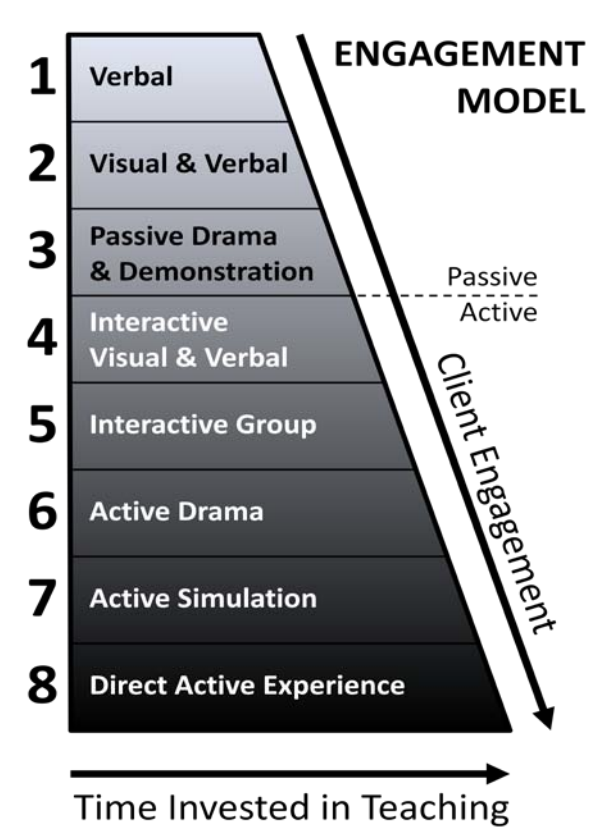How to: Teach Experientially
How to Teach Experientially
Learning engagement is an overall quantity and quality of involvement that clients experience in psychomotor, affective, and cognitive domains. This is one of the defining tenets of experiential education (EE): active and concrete learning experiences tend to be more engaging and/or more effective than passive or abstract ones.
INSTRUCTION
 The Engagement Model shown (with examples) illustrates increasing time investment and client engagement as teaching strategies progress through 8 stages. Like any theoretical model, it is not meant to be a perfect representation of a strategic hierarchy from best to worst. It is simply an indication that experiential strategies offer substantial engagement of client learners.
The Engagement Model shown (with examples) illustrates increasing time investment and client engagement as teaching strategies progress through 8 stages. Like any theoretical model, it is not meant to be a perfect representation of a strategic hierarchy from best to worst. It is simply an indication that experiential strategies offer substantial engagement of client learners.
However, experiential strategies tend to require a greater time commitment from teachers and learners than reading books and/or listening to lectures. This reality is frequently known as the “nemesis” of dedicated experiential educators. The more experiential a lesson is, the more time may be necessary to complete it. For instance, lecturing on the importance of trustworthiness might take ten minutes, while practicing trust falls to develop mutual trustworthiness might take an hour. While the shared message is the same, the lesson learned is quite different.
Experiential strategies also demand that the teacher shift from being a “sage on the stage” to a “guide on the side.” Instead of having all the answers, teachers must now ask questions that get the clients thinking about learning, as each teacher becomes a learning facilitator.
Finally, experiential instruction rarely follows a lesson plan and clients learn individual lessons where one size does not fit everyone. The EE instructor, now facilitator, must customize the learning of knowledge, skills, and values to suit the individual clients as well as their group.
EXAMPLES
- Read an inspiring quote or short passage to promote client introspection and reflection.
- Record client performance and show the video for immediate or objective feedback.
- Dress up as a real or fictional character and use props to interact or dialog with clients.
- Clients solve a mystery by asking questions that can only be answered “yes” or “no.”
- Organize clients in small groups; moderate their group debate for or against an issue.
- Write out and explain a script for clients to act out or role play for one another other.
- Model a geological time scale using a clock or imitate a network of ecological systems.
- Involve clients in real world service learning, where they can apply their newfound skills.
FURTHER RESOURCES
READING
Bisson, J. & Bisson, C. (2019). Outdoor Education Teaching Strategies: Increase Student Engagement While Transforming Your Teaching. Independently Published.
Bisson, C., & Luckner, J. (1996). Fun in learning: The pedagogical role of fun in adventure education. Journal of Experiential Education, 19(2), 108-112.
Gilbertson, K., Ewert, A., Siklander, P., & Bates, T., (2022). Outdoor Education: Methods and Strategies. Human Kinetics. Priest, S. & Gass, M. (2018), Chapter 12: Instructional Skills in Effective Leadership in Adventure Programming. Human Kinetics.
Stremba, B. & Bisson, C. A. (2009). Teaching Adventure Education Theory: Best Practices. Human Kinetics.
VIEWING
Classroom Management -- Outdoor Teaching Strategies (Canada): http://en.beststart.org/sites/en.beststart.org/files/u4/B2_Classroom_Management.pdf
Sir Ken Robinson: Five reasons to teach outside: https://www.youtube.com/watch?v=uilRipTg4hk
Teaching outdoors (UK): https://www.outdoor-learning.org/Good-Practice/Develop-yourOrganisation/Outdoor-Learning-in-Schools/Teaching-Outdoors
This blog was originally published in 2022 by Christian Bisson & Simon Priest as part of the CHIP Project.
The Clearinghouse Information Project (CHIP) is a volunteer-driven effort by educators and practitioners in the Experiential Education (EE) community. Each guest editor contributed a one-page summary and resource list on key EE topics.
Each one-page summary outlines the topic and presents key evidence, opinion by the volunteer author(s), and sustaining content regarding that topic. The list of further resources includes recommended items to consult in order to gain a better understanding beyond the summary, such as reading books or articles and looking at websites or videos.
This project does not claim to be a comprehensive, global or complete picture of every aspect of Experiential Education (EE). This project is entirely volunteer-driven, and each one-page summary and the supporting further resources have been written and curated by individuals who have contributed to each topic.
If you appreciate this free information, then please consider joining us as an AEE member, volunteering on future projects, or donating to the EE community.
All resources published in 2022.
